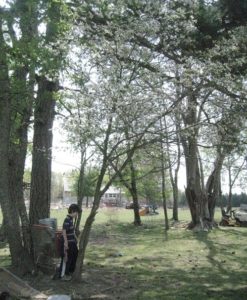
Big Picture Plan: Keeping the Dogwoods
Yesterday the Wiggles went out into our woods. The lesson was about the Dogwood.
This tree is a valuable component in my long-term Land Stewardship goals. It thrives as a naturalized understory tree on southern/eastern aspects in mid slope areas. It seems to like moist and richer soils, if there is such a thing on unmanaged Oak and Hickory woodland in central VA.
The need for managing the land in three dimensions has become one of my criteria as I attempt to maximize land output while maintaining as low an input as possible.
The land is a solar collector. The land that captures and retains the most energy will by default have the largest output.
 The land that produces the most biomass for any given area is the savanna type area that has elephants as primary grazers.
The land that produces the most biomass for any given area is the savanna type area that has elephants as primary grazers.
These are forested grasslands. My goal is to have pasture, trees and food crops growing with synergy and sustainability in this savanna-like structure.
The small tree understory region is a key part of the woodland. I am applying silvopasture principles in my approach of converting deep unmanaged woodland into valuable lumber and food trees with grazing underneath.
My management of the herb and shrub layer in the woodland has been less than stellar. It is mostly non-existent, as I have allowed the grazers in. However, many of the dogwoods were above the browse line and are thriving. I will do my best to allow them to stay as I thin the forest for my long-term goals, so I’m having the family mark them with white ribbons. They are there to say, “I am a Dogwood, don’t squish me.”
 I am particularly fond of the Dogwood, as I have known how to identify them even as a child in Oklahoma. The Redbud is more prevalent there but the dogwood shares in that same niche.
I am particularly fond of the Dogwood, as I have known how to identify them even as a child in Oklahoma. The Redbud is more prevalent there but the dogwood shares in that same niche.
I have found the dogwood to be a rather well mannered tree. It is highly adaptable in form. It adjusts itself to the available solar energy without being pushy or demanding. It takes what it gets and seems to generally thrive, though I have seen them suffer in high temperatures and humidity – this more so in Oklahoma than Virginia.
This friendly tree stays in its space with its slow growth and does not seem to demand a lot of pruning and in fact seems to prune itself quite well in many of the specimens I have witnessed. It allows other things to grow around it without feeling the need to crowd them out. It plays well with everyone.
In my woodland, the Dogwood fills that region that seems to be hardest to fill: the region where the future top canopy trees are fighting each other to try to break through with the biggest crown. There are a lot of trees dying in this region but not the Dogwood. It just does its thing without a lot of drama.
The Dogwood adds beauty and diversity. It supports many insect and bird species. It may support wild mammals as well but I am not certain. It is certainly forage for goats, which is probably its highest practical value on our land. Being a slow grower, it is just a light snack every once in a while but that is at least something.
I feel the small tree/large shrub understory is where the greatest potential lies for food and diversity in the medium term time frame. There are many top canopy trees to sort through as I seek to keep the best nut trees, such as White Oaks and Hickories. There are dead standers for firewood. There are poorly formed trees that will just never have the lumber potential that they could have.
Of all the decisions of what trees to take out and what to keep, the Dogwood is one of the easiest. I am keeping them all until I have a reason to change that.




